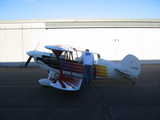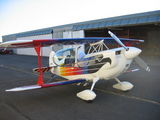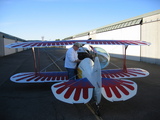My First Aerobatic Biplane Ride Written by Ian Johnston
This story originally appeared in my aviation journal. I got a message on the Biplane Forum today, and it was John (a local pilot I've been chatting with about going up in his Christen Eagle II). He was confirming that we were still on for our flight today. Doubletake Hmm, I thought to myself. I thought that was in a month... Indeed, we'd crossed our dates up, and I'd scheduled for September 27th; he, for August 27th. No matter, I didn't have any firm plans for the evening, so I headed down through nasty commute-time traffic and met him at the Renton airport. John is a genial guy, and I enjoyed talking with him. We discussed his plane, its history, the 10-way partnership which owns it, and its recent work -- they re-covered the wings. The plane was built in 1981 by a group of 10 people, and many of their changes were integrated into later kits. Apparently a lot of them were Boeing engineers. He asked whether I wanted to just go up and cruise around, or do acrobatics. I thought for a second and said, "Acrobatics." I pretty much figured acrobatics weren't my cup of tea, but I wanted to find out for sure. We talked about what we'd do in the air: a 2-point roll, a loop, and a reverse cuban eight. He explained how the parachute worked, and how to fasten the straps. Pre-flight discussion and check done, he rolled the plane out of the hangar. We climbed in, and he got me strapped into the plane: a belt over each shoulder, one to each side, lap-belt style, and one between the legs. Then, there was the redundant lap-belt, an extra safety measure instituted after one aerobatic competitor died from an unfastened strap. He fired up the engine, and we taxied out. He positioned the plane on the runway. I saw the throttle lever move itself forward (the cockpits are positioned tandem, or front-and-back, rather than side-to-side), and I was pressed back into the seat, the engine throbbing loudly in my head. The 200 HP motor pulled the plane aggressively forward. It should, that's 2x the power and 90% of the weight of the 152 I've flown most recently. The plane fairly bounded into the air, sprung up from a dip in the runway. We climbed quickly. I have no idea how quickly, as there was no vertical speed indicator, but it was fast. Clear of the airport, he gave me control of the airplane. The ride immediately went from smooth to bobbling and wonky. I overcontrolled, and basically ignored the rudder pedals. I felt like I was falling sideways out of the plane on alternating sides. I commented over the intercom that I wasn't yet a stick and rudder pilot, and John laughed drily. He took the plane back, and cleared the area by doing a few turns. The nose of the plane is prominent, and blocks a good portion of the view. After the turns, and a few calls on the radio, he set us up for our first maneuver: a 2-point roll. This is a roll where you roll over to inverted, hold it, and then roll back to upright. He asked if I was ready, and I gave the thumbs up. Suddenly, the plane twitched to the left, the world went upside-down, and I was hanging from the harness, the earth trying to yank me out of the plane. It twitched again, and the world was right side up again. John asked how I was doing, and I said I was fine. I was fine, but I can't say I was having a fun time. Next was a loop. He reminded me of the magic word: "hook!" The idea is you say this word, which tightens up the diaphragm, and at the same time, tense up your legs and everything else. This keeps your blood from dropping precipitously out of your head during positive-G maneuvers. It's kind of a cheap version of the fancy high-G suits worn by fighter pilots. He dove to pick up some speed, and pulled up. I said "hook!" and tensed up. My cheeks sagged and my head felt precariously heavy. The sky filled my view, and then we were at the top, and I sagged onto the straps once more, feeling like I was one thread away from falling out of the plane. We continued back out to level. I asked how much altitude the loop had taken, and John said we'd entered at 3500 feet, peaked at 4100, and come out at 3600. That's pretty cool, and doubtless one of the joys of a powerful, light plane. Our final maneuver was a reverse cuban eight, which is (as I understood it), a climb, with a roll to inverted, and then a loop back out to upright. Which is to say, roll over so gravity tugged hard at my harness, then remember to "hook!" and tense up as gravity pulled my face down into a parody of an 80 year old man. We were done with the aerobatics, and my stomach caught up with me. I started sweating in a delayed stress reaction from the wildly variable forces which had been acting on me. John asked what I thought, and I gave him my assessment as far as I could make it at that point: "I don't think I like aerobatics much." We headed back to the airport, flying under the Seattle Class B airspace. The landing was quite smooth, and I was interested to note that John touched the tailwheel down just before the mains. We rolled out and taxied back to the hangar. We talked for perhaps half an hour after the flight, sipping water from a tiny refrigerator which seemed to be stocked for the purpose of cooling anti-nausea water. It did help. I wasn't exactly nauseated, but I wasn't really steady either. That was easily the most thrown-around I've been in a very long time. In fact, even now, hours after the flight, my stomach still feels a bit odd. John explained that for his first few aerobatic lessons he had to sit in the car for 20 minutes after the lesson before he felt up to driving home. We parted company, and I rode home, thinking distressed thoughts about the folly of building a biplane. The time we spent in the air was essentially unlike what I'd been expecting, which bugged me. The problem is, I'd imagined aerobatics as basically feeling like sitting in a straight-and-level plane but with the horizon doing crazy things around me. I'd been intellectually aware that it must involve high G-forces, but the reality of it never really sank in until I was feeling my face sag as I tensed my body to keep the blood up in my head. Similarly, despite all the pictures I'd seen, and the planes I saw at Arlington, the actual experience of sitting in a biplane was very claustrophobic and cramped. It wasn't uncomfortable for the time we were up, but it was obvious that flying to Portland would be pretty much out of the question from a comfort standpoint. The sound and vibration would team up with the one-and-only position you could sit in, and really make a long flight miserable. An open cockpit (the Eagle is fully enclosed) would make it even worse, from the standpoint of comfort. The actual feeling of flying the plane, for the 4 minutes I did it, was depressing, more than anything else. I had no sense of how to get the plane to do what I wanted, with the result that we bobbled around the sky more like someone playing a video game than an experienced pilot guiding an airplane. I couldn't feel the rudder pedals, so the only way I knew I'd pressed on one was when I felt like I was being tipped sideways out of the cockpit. Flying with coordination was out of the question, I was just trying to keep it aimed in the right general direction. From talking with John afterwards, this is pretty much how all first-time pilots treat the plane. I'm not alone. Even so, I prefer to think I fly pretty smoothly (which I do, in the big, dull Cessnas -- they don't give you the control response to make mistakes); it was a blow to my sensitive little ego to fly John's plane so poorly. To be fair, the Christen Eagle is a very sensitive, sporty plane. It's not quite up to the level of a hot competitive aerobatic showstopper, but it's close, perhaps 80% up the scale from what I understand. The Acro Sport II, which is my theoretical choice, is not so far up, perhaps 60% or 70% (with the Cessnas coming in around 30-40%). This is part of the problem: the Eagle is so vastly outside my experience that I don't really have a place to put it. It's just somewhere out there, well beyond what I'm comfortable with. Of course, if I only do what's comfortable in life, it's not going to be very interesting. I do need to push myself beyond my comfort zone once in a while. As I told John after our flight, I now need to separate the "biplane" from the "aerobatics." More importantly, I need to see if I can get up in an Acro Sport II. I guessed, and confirmed, that aerobatics weren't for me. Now I need to see if biplanes are for me, without aerobatics getting in the way. Biplane-ride postscriptA necessary post-script to the last entry is: Thank you John! I really appreciate his willingness to take me up and introduce me to both the world of biplanes and the world of aerobatics. I hope he isn't discouraged by my negative-sounding entry. As I explained to him after the flight, it's very important that I get some experience with these planes before I go devoting a huge chunk of my time and money towards one. If it ends up I don't like them very much, well, thank god I found out now rather than 2 years, $3000 and 300 hours into the project. For what it's worth, my thoughts now are more positive as I separate the aerobatic experience from the biplane experience in my head. I still know for sure that aerobatics aren't for me, but the biplane question deserves more research. As I had somewhat expected, I dreamed about the experience, but not in the way I'd expected. Instead of dreams about falling out of planes, or anything obvious like that, I had a dream that I'd helped John refuel the plane, but in my ham-handedness ended up overfilling the fuel tank. He instructed me to just add a little bit, perhaps a quart or two, and I ended up spraying two and a half gallons in. I'm sure it's closely related to my inability to control the plane well in the air. The nice thing about my lack of ability to control the plane in the air is, well, I've never flown that plane before. How should I possibly know how to control it well? I'm being too hard on myself to expect perfect, smooth abilities in a plane which everyone acknowledges is many times more nimble (and therefore sensitive) than anything else I've ever flown. That's a problem that can be easily fixed with practice. I did it to get where I am now with theater, writing, motorcycles and Cessnas, I can do it with a sensitive biplane, too. Created by Ian Johnston. Questions? Please mail me at reaper at obairlann dot net. |


